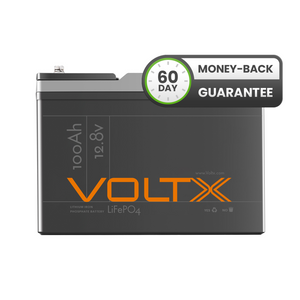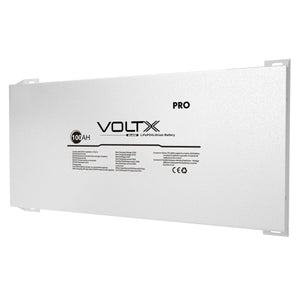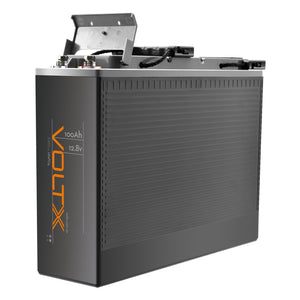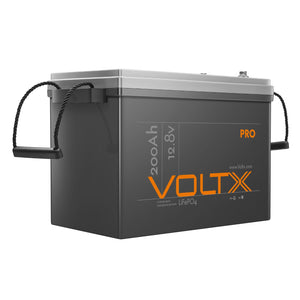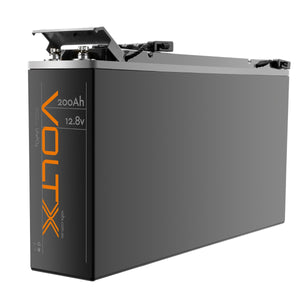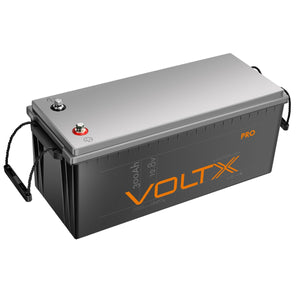Lead acid batteries were the first rechargeable batteries invented and still hold their own today as relatively low-cost batteries that can be used across various applications. Although they have a low energy density, lead-acid batteries can supply a high surge current. The name lead-acid comes from the electrodes and grids in the battery are made from lead, and the electrolyte is sulfuric acid.
There are three main types of lead-acid batteries; flooded cell batteries, (absorbent glass mat) AGM batteries and gel batteries.
Flooded cell batteries are the most traditional technology in lead-acid batteries and are still in common use, including camping, marine and other outdoor activities. This is because they are the most economical of the lead-acid batteries. It is called a flooded cell because the electrolyte is in liquid form and moves freely around the cells. Because of this, there is a chance of spillage or corrosion, and also, these batteries need more maintenance. Regular topping up of the electrolyte solution is required to stop the battery from drying out. If the battery dries out, sulfation may start to occur, and the battery may begin to self-discharge, and premature ageing may start.
AGM batteries represent newer design technology in lead-acid batteries and so are more expensive. However, they have the advantage of being less high-maintenance than the flooded cell because the electrolyte solution does not need topping up as the cells are sealed. AGM batteries also have a reputation for being more efficient to charge and discharge.
Gel lead-acid batteries are similar to AGM batteries in that the electrolyte is suspended. Still, in this case, silica has been added to the electrolyte solution to make a gel-like substance.
What are lead-acid batteries used for?
The most popular and well-known application for lead-acid batteries is starter batteries because they supply the high surge current needed to get an engine going. However, because of their efficiency, performance and overall safety, they have many uses and are the most commonly used type of battery for a range of activities. They can be used as RV batteries and may be used in a setup for solar batteries for a campsite or an RV. You may also install a lead-acid battery without solar to operate the electric gear in your RV or at your campsites, such as the lights or the fridge, so they are well-known to provide a bit of home comfort. For those into 4WD-ing, lead-acid batteries make great second batteries in a dual-battery system, again providing extra and backup power without running down your starter battery. They can also be used as trolling motor batteries, and those who love fishing may use them as marine batteries to power up the boat's electrics, lights, or fridge. Keen golfers will know that it is likely that their golf cart batteries that get them around the green in their golf carts are lead-acid batteries of some kind. They are also used as boat batteries and perhaps as an inverter battery, to name a couple more uses. It could be said that if you have an adventure planned - there 's a lead-acid battery for that.
How to charge a lead-acid battery?
This depends on the type of battery used, and care must be taken to charge your battery correctly to avoid damaging it. Gel batteries, for example, are particularly delicate and can be damaged beyond repair if charged incorrectly. Overall, however, two main methods to charge a lead-acid battery; constant current charging and current-voltage charging.
To charge an AGM battery, it is important to have the recommended charger and make sure that the capacity, measured in amperes, suits the size of your battery. It 's also important to charge your AGM battery fully as charging it only partially and again will mean that your battery will lose its ability to charge fully over time. Temperature is also important - these lead-acid batteries don 't like to be charged when it is too hot or cold.
The best way to charge a flooded battery is by multi-stage charging. This involves four stages: bulk, absorption, float and equalisation. When you charge this type of battery, you need to take care not to allow the lead-acid batteries to remain at any of these stages once they are done as they will either overcharge, undercharge, or you will find they have self-discharged.
With a gel battery, the most important thing to remember is that you need to take it off the charger as soon as the charging has finished. If you forget and leave it on, it will cause internal damage by creating voids with the electrolyte. This kind of damage to your lead-acid batteries is irreversible, so your battery will be useless.
Want to make it all easier? Get a smart charger.
At Outbax, we love the outdoors, and we love helping you get out there. We 've got great offers and fast automated shipping Australia-wide to get you out amongst it sooner.
